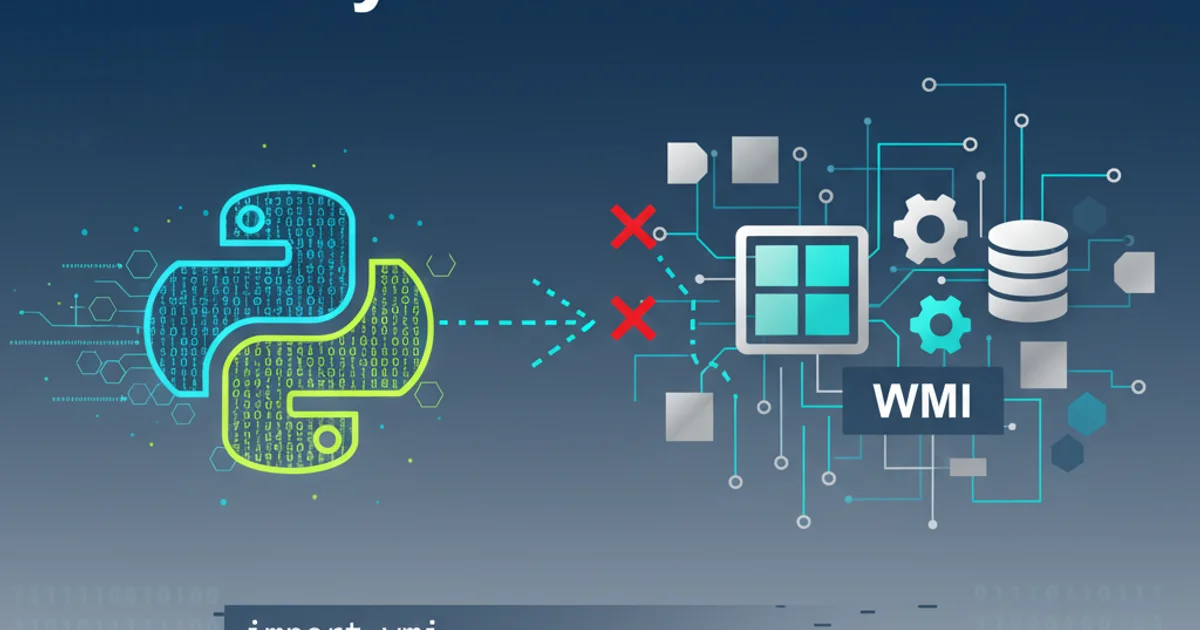Can't import WMI Python module
Categories:
Troubleshooting 'Can't import WMI' in Python

A comprehensive guide to resolving common issues when importing the WMI module in Python, covering installation, environment, and compatibility.
Encountering an ImportError: No module named 'wmi' or similar when trying to use the WMI module in Python can be a frustrating experience. The WMI module is a powerful tool for interacting with Windows Management Instrumentation, allowing Python scripts to query system information, manage processes, and control services on Windows machines. This article will guide you through the common causes of this import error and provide step-by-step solutions to get your WMI scripts running smoothly.
Understanding the WMI Module and Its Dependencies
The wmi module in Python is a wrapper around the COM (Component Object Model) interface to WMI on Windows. It relies on the pywin32 extensions, which provide access to many Windows API functions from Python. Therefore, a successful installation of wmi often depends on a correct pywin32 setup. This dependency is crucial and often overlooked when troubleshooting import issues.
flowchart TD
A[Python Script] --> B{"import wmi"}
B -->|Success| C[WMI Module Loaded]
B -->|Failure: ImportError| D{Check WMI Module Installation}
D -->|Not Found| E[Install 'wmi' via pip]
E --> F{Check pywin32 Dependency}
F -->|Not Found| G[Install 'pywin32' via pip]
G --> H{Verify Installation}
H -->|Success| C
F -->|Found| H
D -->|Found but Error| I[Check Python Environment/Path]
I --> J[Verify Python Architecture (32-bit/64-bit)]
J --> K[Ensure Correct Python Interpreter]
K --> HTroubleshooting Flow for WMI Import Errors
Common Causes and Solutions
The ImportError typically stems from one of three main areas: incorrect installation, environment path issues, or Python version/architecture mismatches. Let's explore each in detail.
wmi.1. Incorrect or Missing Installation
The most frequent reason for ImportError is that the wmi module, or its pywin32 dependency, has not been installed correctly or is missing from your Python environment. The wmi package is not part of the standard Python library and must be installed separately.
1. Install WMI and pywin32
Open your command prompt or terminal and run the following pip commands. It's good practice to install pywin32 first, then wmi.
2. Verify Installation
After installation, open a Python interpreter and try to import the module. If successful, you should not see any errors.
pip install pywin32
pip install wmi
Installing WMI and pywin32 modules
import wmi
c = wmi.WMI()
print("WMI module imported successfully!")
Verifying WMI module import
2. Python Environment and Path Issues
Sometimes, even after successful installation, Python might not find the module. This can happen if you have multiple Python installations, are using a virtual environment incorrectly, or if your system's PATH variable isn't configured to point to the correct Python executable and its scripts directory.
pip command associated with the specific Python interpreter you intend to use for your project. For example, use py -3.9 -m pip install wmi for Python 3.9.where python
where pip
Checking Python and pip executable paths
Ensure that the pip you are using corresponds to the python interpreter you are running your script with. If they don't match, you might install wmi for one Python version but run your script with another.
3. Python Architecture Mismatch (32-bit vs. 64-bit)
The pywin32 extensions, and by extension wmi, are highly dependent on the architecture (32-bit or 64-bit) of your Python installation matching the architecture of your Windows operating system and the COM components it interacts with. While pip usually handles this correctly, manual installations or specific environment setups can lead to issues.
Verify your Python interpreter's architecture. If you are running a 32-bit Python on a 64-bit Windows, or vice-versa, it can lead to problems with modules that interact deeply with the OS like pywin32.
import platform
print(platform.architecture())
Checking Python interpreter architecture